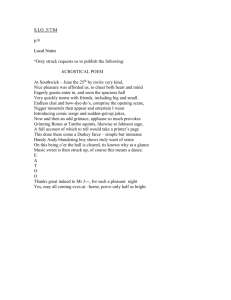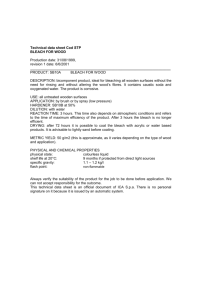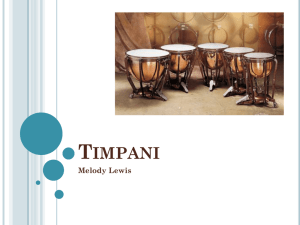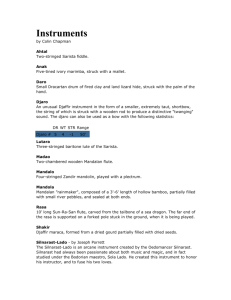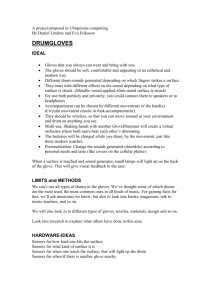percussion instruments of the orchestra
advertisement
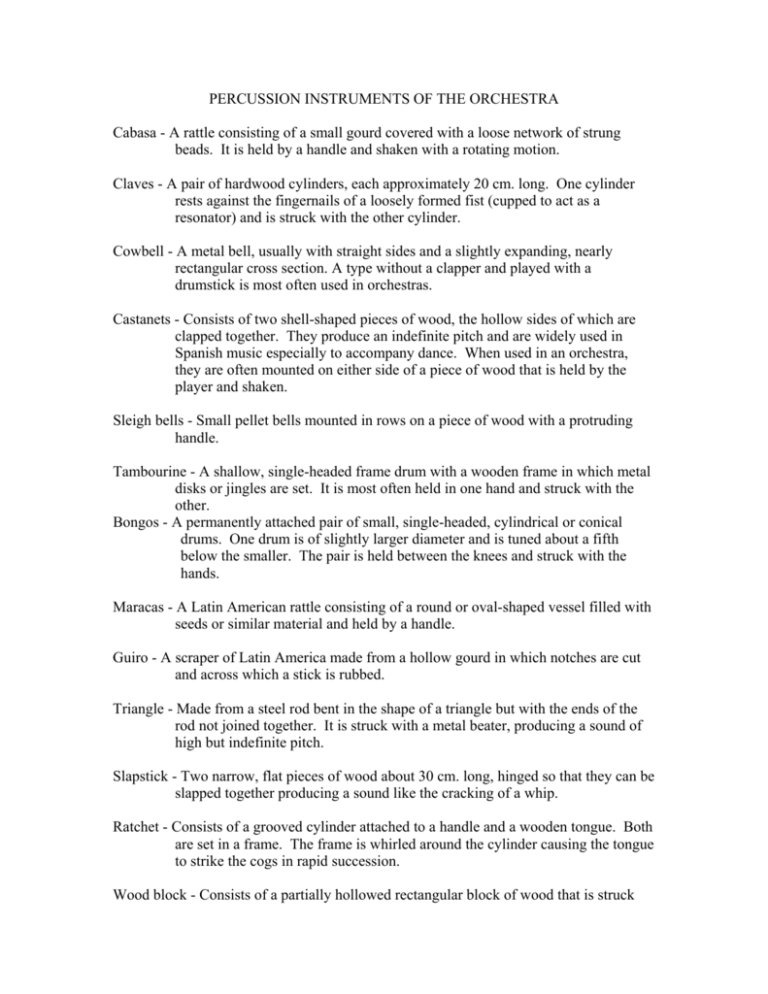
PERCUSSION INSTRUMENTS OF THE ORCHESTRA Cabasa - A rattle consisting of a small gourd covered with a loose network of strung beads. It is held by a handle and shaken with a rotating motion. Claves - A pair of hardwood cylinders, each approximately 20 cm. long. One cylinder rests against the fingernails of a loosely formed fist (cupped to act as a resonator) and is struck with the other cylinder. Cowbell - A metal bell, usually with straight sides and a slightly expanding, nearly rectangular cross section. A type without a clapper and played with a drumstick is most often used in orchestras. Castanets - Consists of two shell-shaped pieces of wood, the hollow sides of which are clapped together. They produce an indefinite pitch and are widely used in Spanish music especially to accompany dance. When used in an orchestra, they are often mounted on either side of a piece of wood that is held by the player and shaken. Sleigh bells - Small pellet bells mounted in rows on a piece of wood with a protruding handle. Tambourine - A shallow, single-headed frame drum with a wooden frame in which metal disks or jingles are set. It is most often held in one hand and struck with the other. Bongos - A permanently attached pair of small, single-headed, cylindrical or conical drums. One drum is of slightly larger diameter and is tuned about a fifth below the smaller. The pair is held between the knees and struck with the hands. Maracas - A Latin American rattle consisting of a round or oval-shaped vessel filled with seeds or similar material and held by a handle. Guiro - A scraper of Latin America made from a hollow gourd in which notches are cut and across which a stick is rubbed. Triangle - Made from a steel rod bent in the shape of a triangle but with the ends of the rod not joined together. It is struck with a metal beater, producing a sound of high but indefinite pitch. Slapstick - Two narrow, flat pieces of wood about 30 cm. long, hinged so that they can be slapped together producing a sound like the cracking of a whip. Ratchet - Consists of a grooved cylinder attached to a handle and a wooden tongue. Both are set in a frame. The frame is whirled around the cylinder causing the tongue to strike the cogs in rapid succession. Wood block - Consists of a partially hollowed rectangular block of wood that is struck with a wooden drumstick or other beater. Temple blocks - Carved from hardwood into a round or oval shape and made hollow with a slit spanning most of the lower half. It is usually played in a set of five different pitches with soft-headed mallets or drum sticks. Conga - A long, single-headed drum played with bare hands. The head is generally larger than the open end, and the shell may bulge slightly below the head. Xylophone - Consists of suspended wooden bars struck with a beater. The wood used for the bars is dense giving the xylophone a bright tone. The wooden bars are arranged like a keyboard giving the instrument definite pitch. Below each wooden bar is a tubular resonator whose length corresponds to the pitch of the bar. The instrument is mounted on a stand and struck with two or more beaters. Marimba - Is like a xylophone but its bars are made from softer, more porous wood giving it a more mellow sound. Its bars are also wider, longer, and larger which produces a sound one octave lower than the xylophone. It too is played with two or more beaters. Chimes - A set of metal tubes of varying length, hung vertically in a frame in an arrangement similar to that of a keyboard. Each tube is struck at the top with one or two rawhide mallets. Timbales - A pair of single-headed, shallow cylindrical drums of Cuban origin that are tuned to different pitches. They are clamped side by side to a waist-high stand and played with two sticks. Timpani - The most important orchestral percussion instrument and the only member of the drum family of Western art music capable of producing notes of definite pitch. It consists of a large hemispherical shell of metal of fiberglass across which is stretched a head of calfskin or plastic. The inner mechanisms of the timpani head allow it to be stretched and tuned. Drum - Any of the instruments known as membranophones, with skin or plastic stretched over a frame of usually wood or metal. They can be struck with the hands, a mallet or drum sticks. In an orchestra, the most common drums are snare, tenor, and bass, and timpani.
